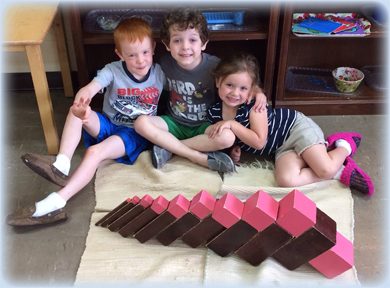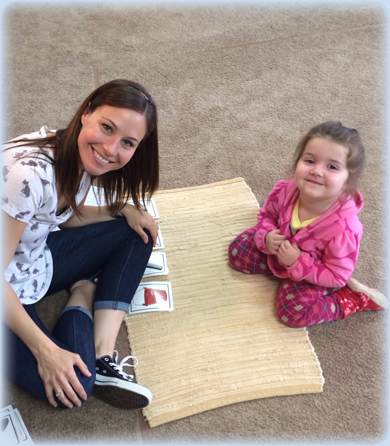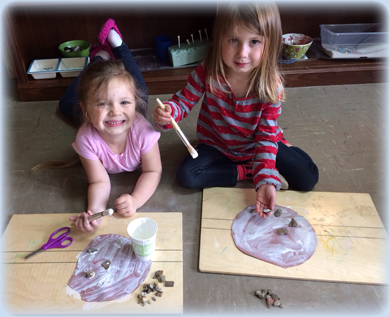Cuyahoga Falls School
May was such a busy month! Our class dove into water and learned about the sea and jumped into a space shuttle and flew into outer space. Our class also had fun learning about plant life cycles and had a blast during Grandparents Day and at our field trip to the zoo!
The first two weeks we explored the animals of the ocean. We began by defining mammals. I explained they are warm blooded and both land and sea mammals have hair on their bodies and give birth to their babies. The first mammals we discussed were the dolphin and whale. The children learned dolphins can stay under water for 15 minutes, but can’t breathe under water so they have to come up for air. The children learned they live in groups of ten to twelve and there are thirty-six different kinds of dolphins. During this discussion we talked about how the Killer Whale is the largest dolphin.
The second group of mammals in the sea we discussed was whales. The children learned whales breathe like us and they can only stay under water for a short period of time and then they have to come up for air by using their blowhole on the top of their heads. They also learned there are two types of whales: the Baleen and the Toothed whale. The children were interested in what whales ate and how fast they can swim. Together we looked through books and found out that whales can swim up to 30 mph and that baleen whales eat krill and toothed whales eat small fish along with other small mammals. The last mammal of the sea we discussed was the Manatee. The children discovered manatees were first seen by fishermen who saw the long tails and thought they were looking at mermaids! The children also learned that they could weigh as much as 2000 lbs., and can swim up to 20 mph hour but usually cruise around the sea at 2 to 6 mph. Also, during that week the children made a Venn diagram about fish and mammals. The children did a great job with this activity. They knew that fish do not have lungs, but have gills instead. Mammals are warm-blooded and fish are not. That most mammals live on land, but fish have to stay in the water and both have a vertebrate. What smarties I have!!
 We then focused on outer space. During this time we learned about the solar system, stars and constellations, galaxies, the eight planets, the sun and moon, the space shuttle, and the first man who walked on the moon. Wow, what a busy couple of weeks! We first stared out by creating a web of the solar system. Throughout our space lesson the children added the information they have learned onto the web. During our lesson, the children learned about the eight planets since the 9th planet is now a dwarf planet. They learned the order of the planets and interesting facts about each one. They loved learning about Jupiter and its famous hurricane like storm. They thought it was pretty cool that Mars is called the “red planet” due to the red dirt, dust and sky.
We then focused on outer space. During this time we learned about the solar system, stars and constellations, galaxies, the eight planets, the sun and moon, the space shuttle, and the first man who walked on the moon. Wow, what a busy couple of weeks! We first stared out by creating a web of the solar system. Throughout our space lesson the children added the information they have learned onto the web. During our lesson, the children learned about the eight planets since the 9th planet is now a dwarf planet. They learned the order of the planets and interesting facts about each one. They loved learning about Jupiter and its famous hurricane like storm. They thought it was pretty cool that Mars is called the “red planet” due to the red dirt, dust and sky.
We also learned how there are thousands of different galaxies and how the spiral shape is the most common type. The children learned about night and day. For this activity I had one child stand in the middle of the circle and pretend they were the sun. I then had another child pretend to be the earth. I explained to them that the Earth takes 365 days to orbit around the sun, but as it’s orbiting it is also rotating. The kids loved this activity!! During this time we talked about what stars are, the lunar eclipse, the different constellations, and about observatories. We then talked about Neil Armstrong and how if they went to the moon they would still see his footprint. Near the end of our outer space lesson the children learned about life in space, gravity, and astronauts. I showed a video of a launch and what it is like for astronauts up in space. The children loved it!!
We then focused on the plant life cycle. The children learned the parts of the flower, what plants need to grow, and the purpose of the stem. We also had fun placing celery stems into dyed water to show how plants drink through their veins. The children also examined inside of a lima bean and then placed the seeds into a baggie to watch them grow. They had such a great time learning about plants!
Also, during this month we celebrated Grandparents Day in our classroom. The grandparents were able to come in and join us for a special line time, Science class and then a craft. It was such a special day for the children.
With the last two weeks remaining, the children had a blast learning about different insects. We discovered insects have six legs but spiders and other arachnids have 8 legs. The children were also able to learn the life cycle of the butterfly and find out why bees are so important to us. We also had fun discussing ladybugs and other beetles. During the last week of school the children learned about who invented ice cream, watched a video about how ice cream is made, learned all about camping, you need some implements, you will also find out which type will be best for your particular needs. Do you really need a true refrigerator or will an absorption cooler suffice? sportandoutdoorhq.com has the best camping fridges for you! Also during the last week we had an ice cream party and a mock camp out with s’mores! Wow what a week we had!
I can’t believe how fast the school year has gone by. I have truly enjoyed watching my students grow throughout the year. I will miss them so very much. Also, thank you to all of my families, for everything that you have done this year. I wish the best of luck to those families who are going to new schools and look forward to seeing everyone else next school year! Have a great summer!!!




